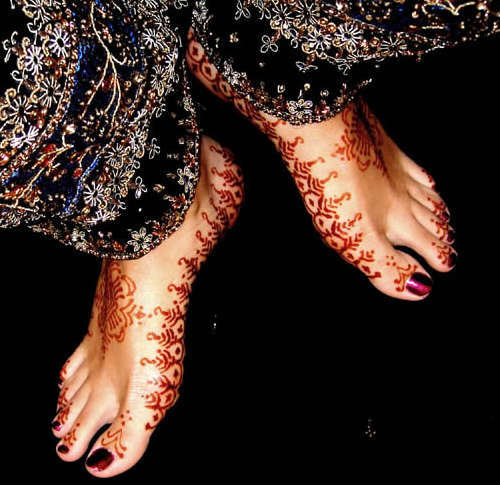FWP:
SETS == MIDPOINTS
HENNA:
{18,4}
SPRINGTIME: {13,2}
Metrically speaking, an i.zaafat after davaam is permissible but not required. Arshi doesn't have an i.zaafat there, so I take his as the preferred reading. But I also like (2c), the reading with the i.zaafat (as Hamid does too).
'Spring is henna on the foot of autumn'-- as Josh says, what could be more complexly meaningful, and also more beautiful? Even in English some of its loveliness comes through. Henna is brightly colored, changing from a kind of greenish shade when first applied to hands and feet, to a vivid reddish color when fully dry. (For more on henna, see {18,4}.) Henna is usually applied in ornate, lacy designs that exult in their own delicacy and extravagance, and of course it is a supremely festive symbol used for celebrations, especially weddings. It is also all too temporary-- within a week or two it has begun to fade, within another couple of weeks it is gone.
Obviously, these qualities resonate with those of springtime. The henna is gorgeous but vulnerable, just a thin little layer-- and as Nazm says, when it's gone 'only the foot of autumn will make itself felt'. The henna of springtime is a brief, deceptive veneer of color and enjoyment. It's false advertising, a bait-and-switch, inducing us to buy into a world full of bleakness and suffering-- an autumnal world. One small benefit might be that if henna is applied to the feet of autumn, it may also prevent autumn from moving until the henna has dried, and thus buy us a bit more time.
But there's no escape-- the assertion in line one, if accepted ('if this is so'), directly implies line two. The force of the second line comes from the heavy weight of davaam , which can be any of three distinct parts of speech. It can be an adjective ('perpetual, permanent') as in (2a), or an adverb ('perpetually, permanently') as in (2b), or a noun ('perpetuity, permanence') as in (2c); in this latter case, we would read davaam with an i.zaafat after it.
In all of these senses, davaam applies to the heavy burden of 'trouble, vexation' (see the definition of kulfat above) that is the opposite of the frail, thin, delicate
layer of henna. The henna of spring, with its vivid and complexly
radiant design that's soon to be worn away, survives
only briefly-- only long enough to seduce us into embracing (to our sorrow)
a world that 'perpetually, permanently' crushes us under its no-longer-hennaed foot.

Nazm:
That is, even if it's spring, so what? It's the red color of henna; in a few days it will fade away-- and then only the foot of autumn will make itself felt. (28)
== Nazm page 28